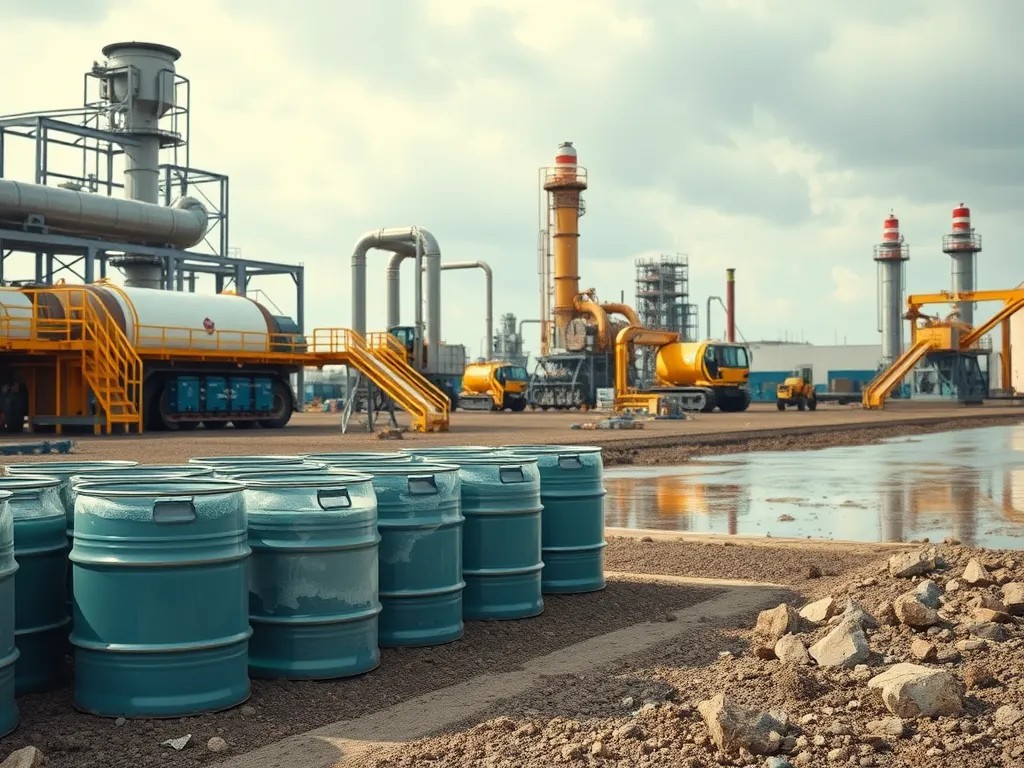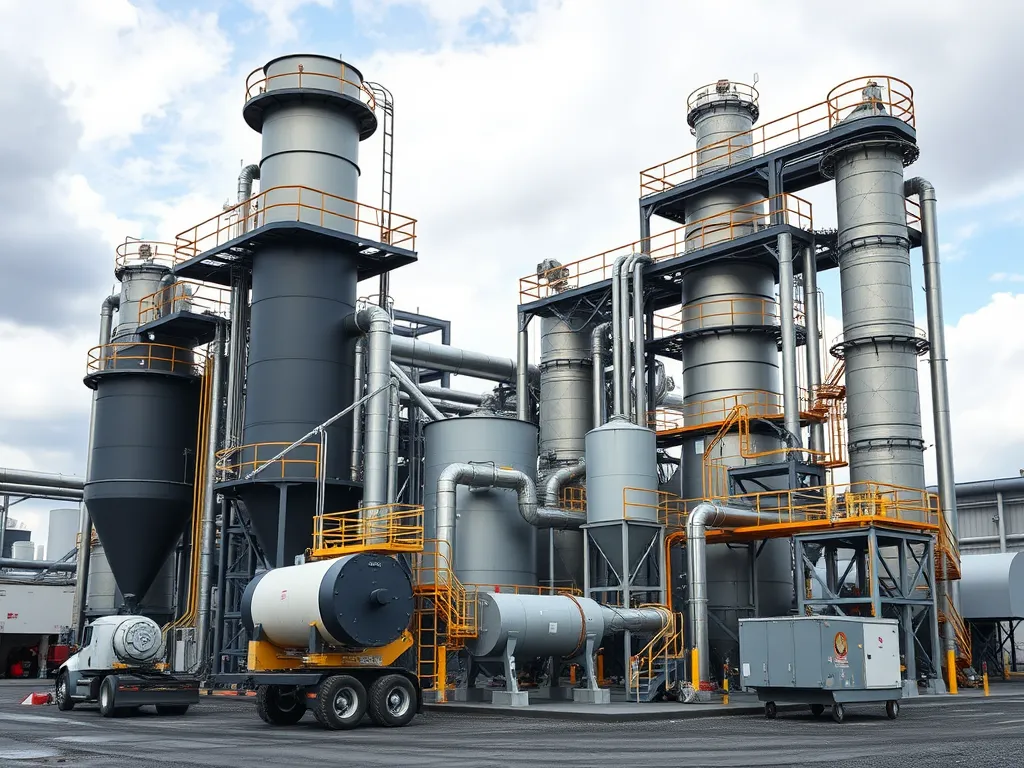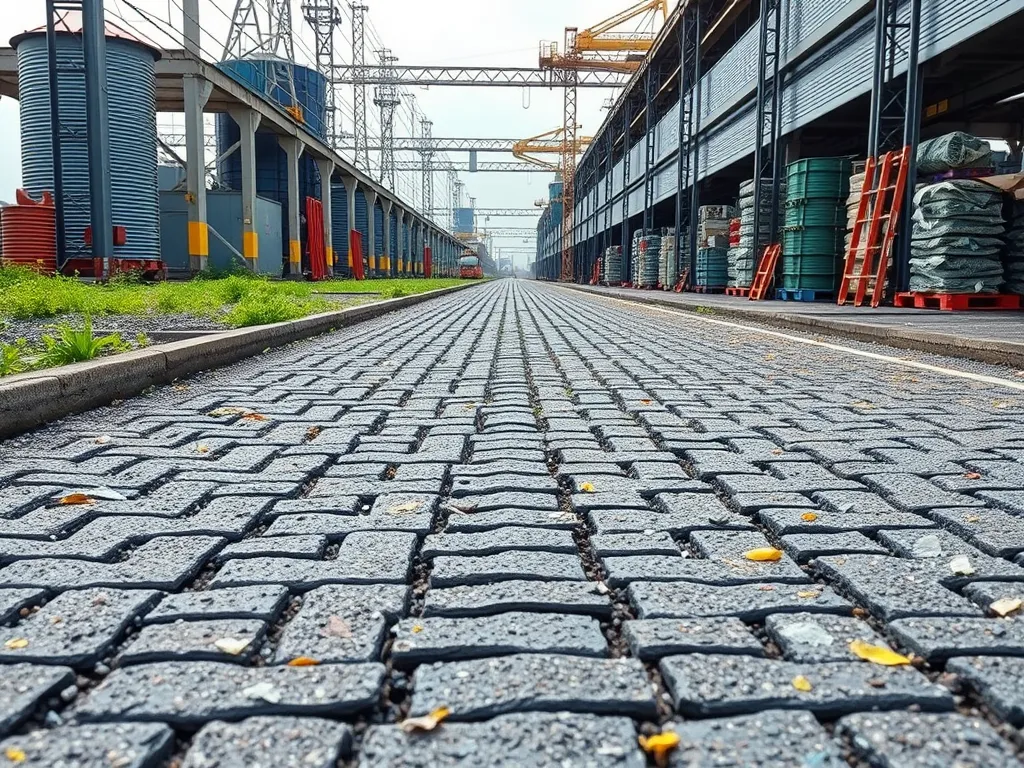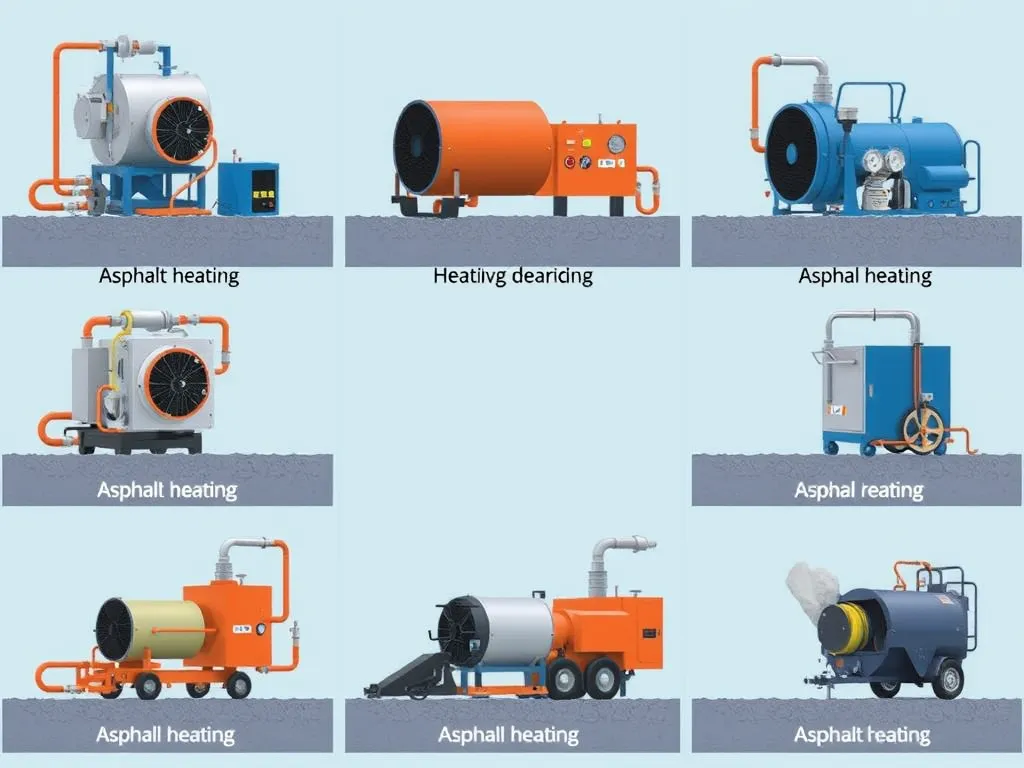Sustainable Bitumen Production for Asphalt: Key Practices & Environmental Considerations
Published on: September 25, 2025 | Last Updated: April 14, 2025
Written By: George Voss
Sustainable bitumen production creates asphalt’s binding agent while minimizing environmental harm through energy-efficient refining, recycled materials like Reclaimed Asphalt Pavement (RAP), and bio-based alternatives. Unlike traditional oil sands extraction—which uses 2-4 barrels of water per barrel of bitumen—modern methods cut CO2 emissions by 15-30% and reduce reliance on finite resources. Innovations like warm-mix asphalt (requiring 20-40% less energy) and plastic-enhanced binders show how the industry is tackling habitat disruption, water pollution, and carbon intensity.
This article explores current practices reshaping bitumen production. We analyze energy-saving plant technologies, RAP recycling rates exceeding 90% in some projects, and breakthroughs like algae-derived binders. You’ll see how regulations mandate 30-50% recycled content in asphalt mixes and why global bitumen demand (110 million metric tons annually) forces urgent eco-upgrades. Data-driven solutions and real-world case studies reveal the path to greener roads.
Contents
- Understanding Bitumen and Its Role in Asphalt
- Bitumen Production Methods
- Is Bitumen a Sustainable Material for Asphalt?
- Sustainability Issues in Asphalt Production
- Sustainable Bitumen Production Methods
- Environmental Impact Mitigation Strategies
- Regulatory Frameworks for Sustainable Asphalt
- Frequently Asked Questions
- Final Words
- Additional Resources for You:
Understanding Bitumen and Its Role in Asphalt
Bitumen forms asphalt’s backbone. This thick, black hydrocarbon comes from crude oil during refining. Known as asphalt binder in road projects, it glues aggregates into solid surfaces.
What is Bitumen?
Bitumen sits in the heaviest part of crude oil. Refineries use vacuum distillation to split it from lighter fuels. Its thick, sticky nature makes it ideal for binding road materials. Over 90% of global bitumen goes into paving.
Bitumen’s Function in Asphalt Pavement
In asphalt mixes, bitumen coats stone and sand. It acts as a waterproof glue that holds pavement layers intact. PG 64-22 binders work in climates with temps from -22°C to 64°C. Proper grading prevents cracks in winter and rutting in summer.
Core Components Of Asphalt Production
Asphalt mixes need three main parts: aggregates (95%), bitumen (5%), and additives. Sustainability gains come from Reclaimed Asphalt Pavement (RAP), which reuses old pavement. Adding 30% RAP can cut new bitumen needs by a third. Warm-mix tech lowers mixing temps by 30°C, trimming fuel costs and fumes. Polymer-modified binders boost road life by 50%, slashing repair frequency.
Looking at how bitumen is made shows both challenges and chances for cutting its climate impact.
Bitumen Production Methods
Bitumen comes from crude oil through steps that shape its green impact. How we pull it from the earth and turn it into road glue affects land, air, and water.
Traditional Bitumen Extraction Processes
Most bitumen starts in oil sands. Workers use surface mining or steam to split thick crude from sand. This needs heavy gear and leaves deep marks on the land.
Oil Sands and Refining for Asphalt Binder
Oil sands in places like Alberta hold 80% of global bitumen. Miners dig up 2 tons of sand for 1 barrel of crude. Refiners heat this crude to 450°F to strip out bitumen. Upgraders then tweak it into road-grade binder. Each barrel needs 3-5 barrels of fresh water, straining local supplies.
Energy Consumption in Conventional Production
Making 1 ton of bitumen burns 700 kWh of power – equal to running a fridge for 8 months. Oil sands projects emit 3.2x more CO2 per barrel than standard oil drills. Hauling and heating add 12% to asphalt’s total carbon load.
These energy costs push firms to seek cleaner paths. Next, we’ll weigh if bitumen can meet today’s needs without stealing from tomorrow.

Is Bitumen a Sustainable Material for Asphalt?
Bitumen’s role in asphalt raises key questions about long-term supply and eco-impact. We assess two core issues: resource life and renewability.
Evaluating Bitumen’s Resource Longevity
Bitumen comes from crude oil, a finite resource. Proven oil sand reserves hold 249.6 billion barrels globally. At current use rates, these may last 50 years. High recycling rates (up to 95% RAP reuse) slow new bitumen demand. Yet each U.S. highway project still needs 3-5% fresh binder. While methods like warm mix tech stretch supplies, crude-based bitumen stays non-renewable.
Renewability Challenges in Asphalt Supply Chains
Bitumen lacks natural renewal cycles. Bio-binders from algae, pine resin, or used cooking oil aim to fill this gap. But these make up less than 2% of global asphalt binder use. Scaling bio-bitumen needs 40% more land per mile of road versus standard mixes. Supply chains also face cost hurdles: plant-based binders cost $80-$120 per ton, double crude-based options. Without rapid tech shifts, asphalt will keep relying on non-renewable stocks.
These hurdles highlight the need to address the environmental toll of bitumen processing.
Also See: Essential Preventative Maintenance for Asphalt Tools
Sustainability Issues in Asphalt Production
Bitumen production faces growing scrutiny as infrastructure needs clash with climate goals. Every ton of asphalt binder requires 30-50 gallons of fuel during refining, creating environmental pressures.
Environmental Consequences Of Bitumen Extraction
Extracting raw materials for asphalt binder impacts air, land, and water systems. Canada’s oil sands operations alone disturb 4,800 km² of boreal forest annually.
Habitat Disruption from Oil Sands Mining
Surface mining strips vegetation, displacing caribou herds and migratory birds. The Athabasca River region saw 65% fewer wetlands near active bitumen production sites between 1999-2022. Restoration efforts struggle to replicate natural hydrology in reclaimed areas.
Water Contamination Risks in Asphalt Binder Production
Processing 1 barrel of bitumen generates 1.5 barrels of toxic tailings. These sludge ponds leak polycyclic aromatic hydrocarbons into groundwater at rates exceeding 7.8 million liters per year in some Alberta facilities. Advanced liner systems cut leakage by 85%, but legacy sites remain problematic.
Carbon-intensive Asphalt Manufacturing Processes
Heating aggregates and bitumen to 300°F accounts for 75% of asphalt’s carbon footprint. Traditional plants emit 18-22 kg of CO₂ per ton of mix – equivalent to burning 2.5 gallons of diesel. Key emission sources include:
- Drum dryer fuel combustion (55% of total)
- Bitumen storage tank heating (22%)
- Material transport (13%)
New warm-mix technologies slash temps by 50°F, cutting emissions 35% without compromising pavement quality.
These challenges set the stage for exploring cleaner production methods. Next, we’ll examine innovations reshaping bitumen processing.

Sustainable Bitumen Production Methods
New ways to make bitumen cut harm to air, land, and water. These steps help meet green goals while keeping roads strong.
Recycling Asphalt to Reduce Bitumen Demand
Old roads hold hidden value. Grind used asphalt to reuse its parts, slashing the need for new bitumen by up to 20% per ton.
Reclaimed Asphalt Pavement (RAP) Integration
RAP mixes old road bits with fresh rock and binder. Plants now use 30% RAP in hot mix with no loss in strength. This saves 1.2M tons of bitumen yearly in the US alone.
Energy-efficient Asphalt Plant Modifications
New plant tech cuts fuel use by half. Warm mix asphalt (WMA) needs 50°F less heat than hot mix, saving 35% energy. Drum dryers with infrared heat and better burners trim CO2 by 15% per ton made.
Low-emission Binders for Sustainable Asphalt Mixes
Bio-based binders from plants or waste oils now replace 25% of bitumen in some mixes. These binders cut fumes during paving and lower VOC levels by 40%. Tests show roads last as long with these green binders.
These steps show how bitumen can be made with less harm. Next, we’ll explore how new rules push for even cleaner ways to build roads.
Environmental Impact Mitigation Strategies
Bitumen production sustainability relies heavily on minimizing ecological harm while maintaining material performance. Innovative approaches target emissions, energy use, and material waste across supply chains.
Reducing Carbon Footprint in Asphalt Production
Traditional bitumen processing emits 15-25 kg of CO2 per ton. Cutting these numbers requires overhauling heating methods and refining practices.
Alternative Fuels for Heating Bitumen
Biofuels like tall oil or pyrolysis liquids now replace 20-40% of natural gas in asphalt plants. Solar thermal systems preheat aggregates up to 140°F, slashing fuel needs by 12%. Trials with hydrogen-powered burners show 30% lower emissions during bitumen heating.
Emissions Control Technologies in Refineries
Scrubbers capture 95% of sulfur oxides from bitumen upgrading. Carbon capture systems at Alberta refineries trap 1.2 million tons annually. Advanced vapor recovery units cut volatile emissions by 80% during storage and transport.
Waste Management in Asphalt Manufacturing
Each ton of asphalt generates 50-100 pounds of waste. Sustainable bitumen production turns these byproducts into assets.
Recycled asphalt shingles supply 5% of binder needs nationally. Bitumen-rich millings get reused through cold-in-place recycling, saving 1.2 gallons of fuel per ton. New additives made from plastic waste boost pavement life while diverting 8,000 tons/year from landfills.
As industries adopt these methods, regulatory frameworks ensure accountability. Next, we examine policies shaping sustainable bitumen extraction and processing.

Regulatory Frameworks for Sustainable Asphalt
Government policies and industry guidelines shape modern approaches to environmentally sustainable bitumen production. These frameworks balance infrastructure needs with ecological protections.
Environmental Compliance in Bitumen Processing
Bitumen refineries must meet strict air quality rules under laws like the Clean Air Act. The EPA limits volatile organic compound (VOC) emissions to 0.35 pounds per ton of asphalt produced. Facilities deploy scrubbers and carbon capture systems to cut sulfur oxide (SOx) and nitrogen oxide (NOx) outputs by 40-60% versus older methods.
Water management protocols prevent contamination during extraction. Oil sands operations in Canada now recycle 85-90% of process water through closed-loop systems. Thermal cracking units use 15% less freshwater per barrel compared to 2010 standards.
Industry Standards for Recycled Asphalt Content
The National Asphalt Pavement Association mandates 20-25% reclaimed asphalt pavement (RAP) in mixes for federal projects. California’s Caltrans requires 35-40% RAP usage on state roads, reducing virgin bitumen demand by 3.2 million barrels annually.
- FHWA Specification 31 mandates performance testing for RAP mixes exceeding 30%
- ASTM D4887 standardizes binder rejuvenation protocols
- LEED v4 awards points for 15%+ post-consumer asphalt content
These standards drive adoption of sustainable methods of extracting bitumen while maintaining pavement durability. High-RAP mixes now account for 82% of U.S. asphalt production, cutting CO₂ emissions by 21 million tons yearly.
As regulations evolve, new focus areas emerge around lifecycle assessments and circular supply chains. Next, we examine emerging technologies reshaping waste management in asphalt manufacturing.
Frequently Asked Questions
Is Bitumen Renewable in Asphalt Applications?
No, bitumen is derived from crude oil, which is a finite resource and not renewable. Current alternatives, such as bio-binders, make up a very small percentage of the global asphalt binder market, highlighting the reliance on non-renewable resources.
How Does Asphalt Production Affect Ecosystems?
Asphalt production can have significant ecological impacts, including habitat disruption from mining activities, which can displace wildlife and degrade natural landscapes. Additionally, water contamination risks are heightened due to toxic tailings produced during bitumen processing.
Can Recycled Asphalt Reduce Bitumen Demand?
Yes, recycling asphalt through Reclaimed Asphalt Pavement (RAP) can significantly reduce the demand for new bitumen. Incorporating RAP in asphalt mixes allows for the reuse of materials, often achieving a reduction of up to 30% in new bitumen requirements.
What Innovations Are Being Developed for Sustainable Bitumen Production?
Innovations include the use of warm-mix asphalt (WMA), energy-efficient plant modifications, and low-emission binders that incorporate bio-based materials. These advancements aim to reduce energy consumption, lower emissions, and utilize waste materials effectively in asphalt production.
How Do Regulatory Frameworks Impact Bitumen Production Sustainability?
Regulatory frameworks set standards for emissions, energy use, and the incorporation of recycled materials in asphalt. Compliance with these regulations not only ensures environmental protection but also encourages the adoption of sustainable practices in the bitumen production industry.
What Role Does Technology Play in Mitigating Environmental Impact?
Technological advancements in emissions control, recycling processes, and alternative heating methods are essential for minimizing the environmental impact of asphalt production. These technologies help reduce carbon footprints and enhance resource efficiency throughout the manufacturing process.
What Are the Economic Implications Of Sustainable Bitumen Production?
Sustainable practices in bitumen production can lead to long-term cost savings through increased efficiency, reduced waste, and lower environmental compliance costs. Additionally, the use of recycled materials can mitigate the volatility of bitumen prices, contributing to more stable production costs for asphalt manufacturers.
Final Words
Sustainable bitumen production is crucial for reducing the environmental impact of asphalt. As we’ve explored, integrating recycling practices, improving energy efficiency, and adopting low-emission technologies are key strategies. Emphasizing ecological responsibility in bitumen extraction and processing can help balance the demands of infrastructure development with the health of our planet.
Industry stakeholders must collaborate to innovate and enforce regulations that promote sustainability. By incorporating reclaimed asphalt pavement (RAP) and prioritizing carbon reduction strategies, they can contribute to a greener future for asphalt production.
For more insights on how to balance asphalt needs with sustainability and to explore tools like our asphalt calculator, check out Asphalt Calculator USA.
Additional Resources for You:
- Lavin, P. (2003). Asphalt Pavements: A Practical Guide to Design, Production, and Maintenance for Engineers and Architects. London: Taylor & Francis.
- Environmental life-cycle impacts of bitumen: Systematic review and new Canadian models – ScienceDirect
- Environmental impact of pavements formulated with bitumen modified with PE pyrolytic wax: A comparative life cycle assessment study – ScienceDirect
- Renewable materials in bituminous binders and mixtures: Speculative pretext or reliable opportunity? – ScienceDirect
- Natural Bitumen For Waterproofing Membranes


